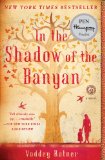Summary | Excerpt | Reading Guide | Discuss | Reviews | Beyond the Book | Read-Alikes | Genres & Themes | Author Bio

A Novel
by Vaddey RatnerThis article relates to In the Shadow of the Banyan
Before the Khmer Rouge (pronounced ki-mer roouze, effectively translating as Red Cambodians) wreaked havoc all over Cambodia and killed approximately one quarter of the country's seven million people, they were mostly a fringe communist guerrilla group operating in the jungles in the north of the country. Early in the 70s, then-Prince Norodom Sihanouk was deposed in a coup and, to retain support, he decided to seek the Khmer Rouge's help. This one move granted the group legitimacy and soon the Khmer Rouge, under the leadership of Pol Pot, became fairly popular in the villages and then slowly made their way into the cities.
 Pol Pot had grand plans - he decided that Cambodians didn't require education or religion. All the country needed was an agrarian model of society so everyone could eat and survive. This meant of course that many had to be forced into agriculture. The Khmer Rouge achieved this by displacing millions of Cambodians from cities and moving them into forced labor camps in the countryside. Families were split asunder, each person serving a basic function in the overall chain of command. Those who were seen as a threat or who resisted were killed, while many others died from starvation and exhaustion under extreme conditions.
Pol Pot had grand plans - he decided that Cambodians didn't require education or religion. All the country needed was an agrarian model of society so everyone could eat and survive. This meant of course that many had to be forced into agriculture. The Khmer Rouge achieved this by displacing millions of Cambodians from cities and moving them into forced labor camps in the countryside. Families were split asunder, each person serving a basic function in the overall chain of command. Those who were seen as a threat or who resisted were killed, while many others died from starvation and exhaustion under extreme conditions.
Soon the organization decided that Democratic Kampuchea (as Cambodia was renamed under the Khmer Rouge) needed to be cleansed of "polluting elements." As a result, professionals, foreigners (or anybody who looked even remotely "foreign"), the intelligentsia, and those considered unfaithful to the cause, were summarily executed in the country's "killing fields." (Today, some of these killing fields serve as memorials to those who died, and Buddhist shrines called stupas house the bones of the dead.)
 During the 70s, neighboring Vietnam was undergoing turmoil of its own, but this did not prevent the two countries from clashing repeatedly. Pol Pot and the Khmer Rouge were eventually displaced in 1979 when Vietnam invaded from the North. In 1998, Pol Pot died in hiding - never having been brought to trial for his atrocities.
During the 70s, neighboring Vietnam was undergoing turmoil of its own, but this did not prevent the two countries from clashing repeatedly. Pol Pot and the Khmer Rouge were eventually displaced in 1979 when Vietnam invaded from the North. In 1998, Pol Pot died in hiding - never having been brought to trial for his atrocities.
Other members of the Khmer Rouge were only recently (circa 2011) brought to trial through a special tribunal set up under the auspices of the United Nations. Even if these leaders were sentenced to prison, many Cambodians believed justice had not been adequately served in response to one of history's most horrific genocides.
Today, Cambodia has a multiparty democratic system under a constitutional monarchy.
For more information, watch PBS's excellent documentary on the Khmer Rouge and Pol Pot, below (begins at 1 minute 20 seconds). Or look at Time's photo gallery entitled "The Legacy of Pol Pot: A Photographic Record of Mass Murder."
Filed under People, Eras & Events
![]() This "beyond the book article" relates to In the Shadow of the Banyan. It originally ran in September 2012 and has been updated for the
June 2013 paperback edition.
Go to magazine.
This "beyond the book article" relates to In the Shadow of the Banyan. It originally ran in September 2012 and has been updated for the
June 2013 paperback edition.
Go to magazine.
Your guide toexceptional books
BookBrowse seeks out and recommends the best in contemporary fiction and nonfiction—books that not only engage and entertain but also deepen our understanding of ourselves and the world around us.